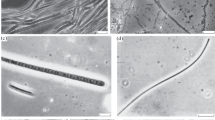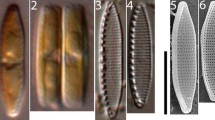Abstract
In the Mammoth Springs (Yellowstone National Park) waters with near neutral pH and soluble sulfide (H2S, HS−, S2−) of over 1–2 mg/liter (30–60ΜM) are characterized by substrate covers of phototrophic bacteria (Chloroflexus and aChlorobium-like unicell) above 50‡C and by a blue-green alga (Spirulina labyrinthiformis) below this temperature.Synechococcus. Mastigocladus, and other blue-green algae typical of most hot springs of western North America are excluded, apparently by sulfide. The sulfide-adaptedSpirulina photosynthesized at maximum rates at 45‡C and at approximately 300 to 700ΜEin/m2/sec of “visible” radiation. Sulfide (0.6–1.2 mM) severely poisoned photosynthesis of nonadapted populations, but those continuously exposed to over 30ΜM tolerated at least 1 mM without inhibition. A normal14C-HCO3 photoincorporation rate was sustained with 0.6–1 mM sulfide in the presence of DCMU (7ΜM) or NH2OH (0.2 mM), although both of these photosystem II inhibitors prevented photoincorporation without sulfide. Other sulfur-containing compounds (S2O3 2− SO3 2−, S2O4 2− thioglycolic acid cysteine) were unable to relieve DCMU inhibition. The lowering of the photoincorporation rate by preferentially irradiating photosystem I was also relieved by sulfide. The most tenable explanation of these results is that sulfide is used as a photo-reductant of CO2, at least when photosystem II is inhibited. It is suggested that in some blue-green algae photosystem II is poisoned by a low sulfide concentration, thus making these algae sulfidedependent if they are to continue photosynthesizing in a sulfide environment. Presumably a sulfidecytochrome reductase enzyme system must be synthesized for sulfide to be used as a photo-reductant.
Similar content being viewed by others
References
Allen, E. T. and Day, A. L. 1935. Hot springs of the Yellowstone National Park.Carnegie Inst. Wash. Publ. No. 466, 525 pp.
Anagnostidis, K. And Golubić, S. 1966. über die ökologie einiger Spirulina-Arten.Nova Hedwigia 11: 309–333.
Bargar, K. E. and Muffler, L. J. P. 1975. Geologic map of the travertine deposits, Mammoth Hot Springs, Yellowstone National Park, Wyoming. Miscell. Field Studies Map MF-659, U. S. Geol. Survey, Wash. D. C.
Brock, T. D. 1973. Lower pH limit for the existence of blue-green algae: Evolutionary and ecological implications.Science 179: 480–482.
Castenholz, R. W. 1969. Thermophilic blue-green algae and the thermal environment.Bacteriol. Rev. 33: 476–504.
Castenholz, R. W. 1970. Laboratory culture of thermophilic cyanophytes.Schweiz. Z. Hydrol. 32: 538–551.
Castenholz, R. W. 1972. Low temperature acclimation and survival in thermophilicOscillatoria terebriformis. pp. 406–418.In: Taxonomy and Biology of Blue-green Algae. T. V. Desikachary, editor. University of Madras.
Castenholz, R. W. 1973a. Ecology of blue-green algae in hot springs, pp. 379–414.In: The Biology of Blue-green Algae. N. G. Carr and B. A. Whitton, editors. Blackwell, London.
Castenholz, R. W. 1973b. The possible photosynthetic use of sulfide by the filamentous phototrophic bacteria of hot springs.Limnol. & Oceanogr. 18: 863–876.
Castenholz, R. W. 1976. The effect of sulfide on the blue-green algae of hot springs. I.New Zealand and Iceland. J. Phycol. 12: 54–68.
Cheniae, G. M. and Martin, I. F. 1972. Effects of hydroxylamine on photosystem II. II. Photoreversal of the NH2OH destruction of O2 evolution. Plant Physiol.50: 87–94.
Cohen, Y., Padan, E., and Shilo, M. 1975a. Facultative anoxygenic photosynthesis in the cyanobacteriumOscillatoria limnetica.J. Bacteriol. 123: 855–861.
Cohen, Y., JØrgensen, B. B., Padan, E., and Shilo, M. 1975b. Sulphide-dependent anoxygenic photosynthesis in the cyanobacteriumOscillatoria limnetica.Nature 257: 489–492.
Doemel, W. N. and Brock, T. D. 1970. The upper temperature limit ofCyanidium caldarium.Arch. Mikrobiol. 72: 326–332.
Knaff, D. B., Buchanan, B. B., and Malkin, R. 1973. Effect of oxidation-reduction potential on light-induced cytochrome and bacteriochlorophyll reactions in chromatophores from the photosynthetic green bacteriumChlorobium.Biochim. Biophys. Acta 325: 94–101.
Knobloch, K. 1966a. Photosynthetische Sulfid-Oxydation grüner Pflanzen. I.Mitteilung. Planta (Berl.) 70: 73–86.
Knobloch, K. 1966b. Photosynthetische Sulfid-Oxidation grüner Pflanzen. II.Mitteilung. Planta (Berl.) 70:172–186.
Kratz, W. A. and Myers, J. 1955. Photosynthesis and respiration of three blue-green algae.Plant Physiol. 30: 275–280.
Kusai, K. and Yamanaka, T. 1973a. The oxidation mechanisms of thiosulphate and sulfide inChlorubium thiosulphatophilum: Roles of cytochrome c-551 and cytochrome c-553.Biochim. Biophys. Acta 325: 304–314.
Kusai, A. and Yamanaka, T. 1973b. Cytochrome c (553,Chlorobium thiosulfatophilum) is a sulfide-cytochrome c reductase.FEBS Letters 34: 235–237.
Kusai, A. and Yamanaka, T. 1973c. A novel function of cytochrome c (555,Chlorobium thiosulfatophilum) in oxidation of thiosulfate.Biochem. Biophys. Res. Commun. 51: 107–112.
Lemasson, C., Tandeau de Marsac, N., and Cohen-Barzire, G. 1973. Role of allophycocyanin as a light-harvesting pigment in cyanobacteria.Proc. Nat. Acad. Sci. USA 70: 3130–3133.
Lenz, J. and Zeitzschel, B. 1968. Zur Bestimmung des Extinktionskoeffizienten für Chlorophyll a in Methanol.Kieler Meeres-Forschungen 24: 41–50.
Madigan, M. T. and Brock, T. D. 1975. Photosynthetic sulfide oxidation byChloroftexus aurantiacus, a filamentous, photosynthetic, gliding bacterium.J. Bacteriol. 122: 782–784.
Meeks, J. C. and Castenholz, R. W. 1971. Growth and photosynthesis in an extreme thermophile,Synechococcus lividus (Cyanophyta). Arch.Mikrobiol. 78: 25–41.
Meyer, T. E., Bartsch, R. G., Cusanovich, M. A., and Mathewson, J. H. 1968. The cytochromesof Chlorobium thiosulfatophilum.Biochim. Biophys. Acta 153: 854–861.
Myers, J. and Kratz, W. A. 1955. Relations between pigment content and photosynthetic characteristics in a blue-green alga.J. Gen. Physiol. 39: 11–22.
Peary, J. and Castenholz, R. W. 1964. Temperature strains of a thermophilic blue-green alga.Nature 202: 720–721.
Pfennig, N. and Trüper, H.G. 1974. The phototrophic bacteria, pp. 24–64.In: Bergey's Manual of Determinative Bacteriology. R. E. Buchanan and N. E. Gibbons, editors. Williams & Wilkins, Baltimore.
Pickett, J. M. and Myers, J. 1966. Monochromatic light saturation curves for photosynthesis inChlorella.Plant Physiol. 41: 90–98.
Pierson, B. K. and Castenholz, R. W.1971. Bacteriochlorophylls in gliding, filamentous prokaryotes from hot springs.Nature 233: 25–27.
Pierson, B. K. and Castenholz, R. W. 1974a. A phototrophic gliding filamentous bacterium of hot springs,Chloroflexus aurantiacus, gen. and sp. nov.Arch. Mikrobiol. 100: 5–24.
Pierson, B. K. and Castenholz, R. W. 1974b. Studies of pigments and growth inChloroflexus aurantiacus, a phototrophic filamentous bacterium.Arch. Mikrobiol. 100: 283–305.
Rowe, J. J., Fournier, R. O., and Morey, G. W. 1973. Chemical analysis of thermal waters in Yellowstone National Park, Wyoming, 1960–65.Geological Survey Bull. 1303.
Sistrom, W. R. and Clayton, R. K. 1964. Studies on a mutant ofRhodopseudomonas spheroides unable to grow photosynthetically.Biochim. Biophys. Acta 88: 61–73.
Stewart, W. D. P. and Pearson, H. W. 1970. Effects of aerobic and anaerobic conditions on growth and metabolism of blue-green algae.Proc. Roy. Soc. London B 175: 293–311.
Weller, D., Doemel, W., and Brock, T. D. 1975. Requirement of low oxidation potential for photosynthesis in a blue-green alga (Phormidium sp.).Arch Mikrobiol. 104: 7–13.
White, D. E., Hem, J. D., and Waring, G. A. 1963. Chemical composition of subsurface waters.U. S. Geological Survey Prof. Paper 440-F.
Author information
Authors and Affiliations
Rights and permissions
About this article
Cite this article
Castenholz, R.W. The effect of sulfide on the blue-green algae of hot springs II. Yellowstone National Park. Microb Ecol 3, 79–105 (1977). https://doi.org/10.1007/BF02010399
Issue Date:
DOI: https://doi.org/10.1007/BF02010399




